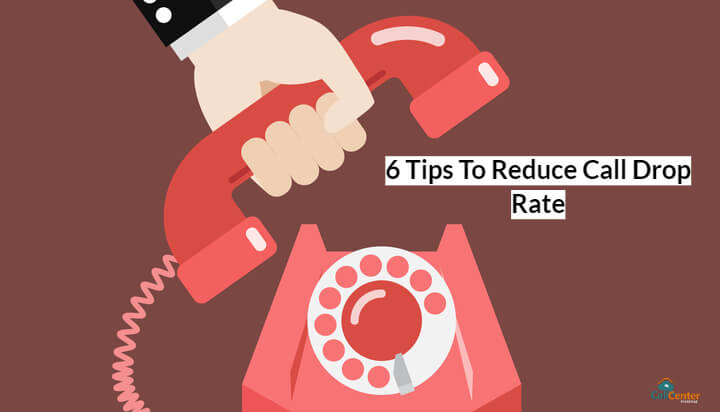How to Reduce Call Drop Rate in a Call Center
Update: This article was recently updated to reflect the accuracy and up-to-date information on the page.
With increasing call volume, call drop has turned out to be one of the biggest problems in the call center environment and for various reasons, customers are accessing the customer support inadvertently in a larger number.
The final decision making related to a product or a service is getting more and more dependent on a consultation of the experts or support agents. Customers are looking for such consultation to reach a meaningful solution.
The contemporary call center solutions have consolidated the scenario in a much better way and have made it more productive towards handling the voluminous calls on a daily basis that challenges the current scenario of the customer support system.

Call drop signifies that the efficiency of the call center is not able to match with the demands of the customer support environment. Customer wait time is another factor that is affected by various reasons such as agent awareness and their ability to handle the customer query efficiently.
Here are three ways to help you reduce call drop rate or abandon rates in your call center.
1. Intelligent Distribution of Calls
With the advent of cloud, the call centers are using the automatic distribution of call as the inbound call centers have become more occupied and unavailable with time. Automatic Call Distribution (ACD) is one of the key ways to create a platform for agents to receive the calls meaningfully and make the best out of it.
It helps to manage incoming calls by selecting an order to distribute or route the calls among agents, immediately.
In addition to this, Skill-based call routing is another feature that helps a lot while dealing with the customer queries as the customers get the most suitable solutions in the least time invested.
Basically, skill-based routing is a call assignment strategy used in various call centers to route the incoming calls to the most suitable agent, instead of choosing the next available agent.
Because agents deal with a variety of calls that’s why it is crucial to route the call to the most suitable agent who can provide the solution, so that possibility of call drop gets minimal.
2. Using IVRs as a Self-Help Tool
Interactive Voice Response (IVR) is one of the best self-help tools that guide customers in a meaningful way.
IVR allows a computer system to interact with the caller through the use of DTMF tone, voice, and keyboard input. These systems respond with pre-recorded messages according to a caller input.
It becomes the responsibility of the service provider to design an IVR system that is easy to use and intuitive. An easy menu helps the customers effectively as they may find a solution on their own and in any case, if the solution is not visible then a line to the live agent is always open.
By using IVR, customers can quickly get the solutions on their own, which results in customer satisfaction and trust.
3. Giving Your Customers a Call Back Option
The callback option is one of the best possible ways to make your customers connected with your business and to eliminate the hold time in a meaningful way.
In the callback option, the customers are given an option of receiving a callback by dropping their number.
At the call center, once a customer chooses the callback option and shares their number, the agent receives a notification which allows them to call back the customer using their given contact number. This strategy elevates customer experience as neither they need to hold on call in queue nor this call will charge them.
4. Alter the Frequency of Queue Messages
Playing a similar pre-recorded message can irritate the customers while they are on hold. Instead of playing the same message you can switch messages until they get connected to an agent. Because on every repetition, customers go away from their activity.
Also, most of the people prefer to hear music while they wait in a call queue. “71% of customers like to listen to music while they are on hold.”
5. Use of CRM Integrated Software
Use of CRM (Customer Relationship Management) helps to monitor call volume patterns based on hours, days, weeks, and months. By analyzing this data, managers can staff cloud based contact center agents for peak hours so that queues don’t stack up and go out of control.
6. Increase Ring Time
“Ring-Ring” sound is more familiar to customers and reduces the chances of call drop. Because it is psychologically proven that most of the people are used to hear the ring instead of an automated message.
If a call begins with an automated message, it can irritate callers. Rather than playing an automated message at the beginning of the call, begin the call with few rings first. The average phone ring time is 18 seconds, or you can experiment between 15 and 20 seconds before playing your first automated message. This small change will help to reduce the abandon call rate of your call center.
Drop Every Possibility of Getting a Call Dropped
The volume of the calls is increasing rapidly and making a call center environment more challenging. The increasing gap between customers and call centers can only be filled up by making use of the resources in a very efficient way and choosing the methods mentioned above to handle the call volume.
Latest posts by Naina Rajput (see all)
- Different Types of Toll Free Numbers: How To Select One? - December 19, 2019
- Telefundraising: What Businesses Need To Know - December 16, 2019
- [Infographic] How Good Customer Service Can Boost Your Business ROI - September 20, 2019








Leave a Reply
Want to join the discussion?Feel free to contribute!